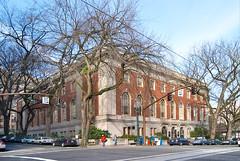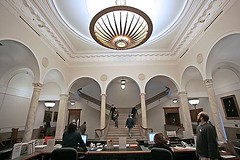Central library planning redux
In a blog entry last month, I wrote about the Portland streetcar, mentioning a Seattle Times travel article about Portland. Somehow I missed a part in the article "A streetcar to inspire, in Portland," that discusses the difference between the two cities and their central libraries.
 Seattle Central Library, photo from the American Institute of Architects.
Seattle Central Library, photo from the American Institute of Architects.WRT modern vs. classical design in libraries, Seattle has built a Rem Koolhaas-designed place. Portland has a library from the early part of last century, recently renovated (and ironically, the new director of the DC Public Library system worked in Portland during the time of that renovation. From the article:
Hop the streetcar a few more blocks to downtown and get off by Portland's Central Library at 11th and Taylor (the entrance is on 10th). The restored 1913 edifice with grand staircases and chandeliers is another Portland yin to Seattle's yang.
Where would you rather spend an afternoon, at the ultra-modern library in downtown Seattle or the historical library in Portland, my wife asked our daughter. "Oh, Portland!" our daughter exclaimed. "It's a beautiful library! The one in Seattle makes you feel like a pod person!"
 Multnomah County Central Library, Portland, Oregon. Photo by Miles Hochstein, Portland Ground.
Multnomah County Central Library, Portland, Oregon. Photo by Miles Hochstein, Portland Ground. MARK HARRISON / THE SEATTLE TIMES. The streetcar has a stop near Portland's Central Library, in a grand 1913 building.
MARK HARRISON / THE SEATTLE TIMES. The streetcar has a stop near Portland's Central Library, in a grand 1913 building. With regard to the process in DC, the proposal is very much "satisficed", calling for a facility half the size of the current library and about half the size of new central libraries being built elsewhere (such as Seattle).
And the proposal calls for $100 million in private donations, when (1) DC doesn't have a good track record for attracting such (our major industry isn't private, but the federal government, so we don't have lots of indigenous rich people hanging around with open checkbooks, and (2) Seattle raised "only" $14 million (not $100 million) in private contributions as part of its project.
I have written about this pretty extensively. It's also very controversial in some quarters because the proposal calls for (1) mixed use; and (2) the deaccessioning and lease to private interests of the current library, a Mies van der Rohe building.
WRT the latter, I happen not to be a fan of modern architecture, but the proposal, overall, has so many many problems. It gives "caring" about "public spaces and the public realm" and "mixed use" a bad name.
This is a blog entry from January about some of the issues: DC Library Planning Part ? and this from November: Citizen Summit and Libraries.
Katie Salay of PPS calls our attention to this piece at ArchNewsNow, "Reference This: Two views on trends in public and academic libraries." The interview with Mark Schatz, AIA, Field Paoli, focuses on "recent changes in public libraries, especially smaller community libraries." From the piece:
Mark Schatz: One trend we are seeing more of is the multi-use building. The library, senior center, teen center, gym, all together.
KC: Is this something communities are demanding? Or is it mostly an issue of keeping construction and operations costs down?
Schatz: I think it's a matter of synergy more than budget. For years architects worked with this concept, which seemed rooted in the 1950s, that you had a city plan that gave each use its own discrete area. And you would drive from home to business to retail to school to library. That's not the tradition of cities prior to that period. Residences and offices were over the shops; uses and people commingled. You could get most of what you needed within a short distance. Architects and urban designers are finding ways to change various codes and ordinances to encourage mixed use, and one area we are seeing that effort is with community facilities. It's part of a significant, larger trend.
He also discusses linking retail in with planning, how you need to look at different user segments (he calls them "layers") and how their needs differ and how to design and respond to these different needs, as well as public participation issues.
The interview with Ed Dean, AIA, LEED, Chong Partners, focuses on trends and design of "large urban libraries," and college libraries too, developments within which are relevant to urban centers. (They don't discuss the impact of book superstores on libraries, although this piece from the Seattle Times, "Meet your new Central Library: It's both a testament to and test of civic chutzpah," mentioned in this blog entry "Today's Library hearing testimony" covers that issue. From the ArchNewsNow piece:
Ed Dean: Libraries are becoming a kind of public forum. They are one of the last places where people can intersect, get public service, and shop for information. They're becoming less about checking out a book and more about finding services and interacting. There are homework centers, computer training centers. I reviewed the plans for a new library in San Bernardino, California ?it hasn't been built yet, but a prominent feature in the design is a community garden that occupies the entire roof. The biggest change I've seen is the addition of computers for children. A lot of larger libraries now have arrangements with the school district to provide a high-tech classroom. The districts don't tend to have the resources.
The article is full of good images as well and you need to read it.
For various reasons, I think we need to stick with the current Central Library, fix it, expand it, add other functions (such as City Museum, archival, and visitor functions, and look at working to bring other special libraries into the mix such as the independent Foundation Center Library currently located on K Street NW).
Something I wrote about that is here:
-- Central Library Planning efforts and the City Museum, how about some learning from Augusta, Maine ... and Baltimore? and
-- MLK Library: Eyesore or Modern Masterpiece?
Index Keywords: libraries



0 Comments:
Post a Comment
<< Home